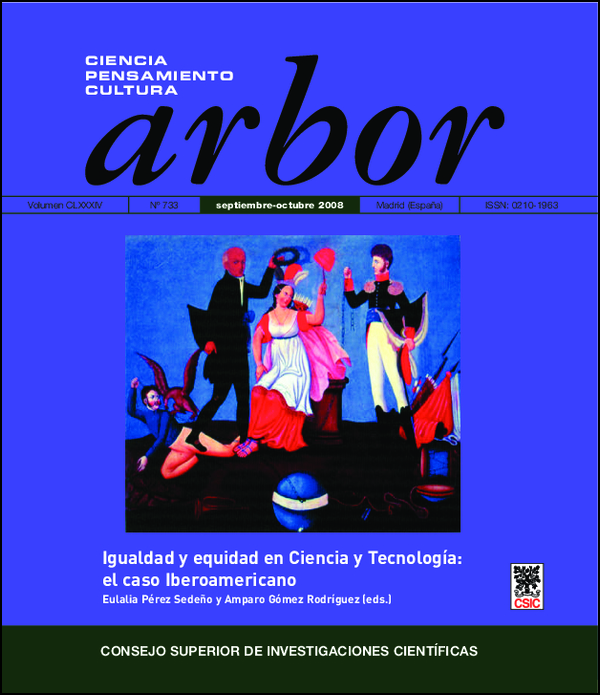Women in the Academy. A Chiaroscuro painting of UCV
DOI:
https://doi.org/10.3989/arbor.2008.i733.229Keywords:
UCV, gender, higher education, teaching and research, VenezuelaAbstract
For a long time the Central University of Venezuela (UCV) was the only national institution providing professional and academic education to citizens. At present, although it shares these functions with a set of public and private institutions, it continues to produce the largest contingent of science and engineering graduates in the national domain, has the largest number of graduate programs and of researchers. Its graduates have steadily grown since 1950 and that increase has occurred to a large extent thanks to the feminine contribution. In this work we analyze women’s participation in the university life, and in the processes of doctoral formation, as well as in the research system of this premier institution.
Downloads
References
Alcibíades, Mirla (s-f): “Moral femenina y vida social: los patricios auspician la instrucción femenina”, biblioteca electrónica, Caracas, Venezuela, consultada en http://www.analitica.com/bitblio/mirla_alcibiades/moral_femenina.asp . Capturada el 03-04-2007.
Aray, María Alejandra; Canino, María Victoria y Vessuri, Hebe (2007): “El trabajo femenino en las industrias del plástico del área metropolitana de Caracas”, Revista Venezolana de Economía y Ciencias Sociales, vol. 31, n.º 1, enero.
Clark, William (1989): “On the dialectical origins of the research seminar”, History of Science, 27: 111-154.
CONICIT (1998): Sistema de Información de Becarios Investigadores en Conicit-SIBIC, CONICIT, Caracas.
Cruces H., José Miguel y Hebe Vessuri (2005): “La nueva agricultura: desafíos para la enseñanza agrícola superior en Venezuela”, en Antonio Arellano H., Pablo Kreimer, Jorge Ocampo L. y Hebe Vessuri (compiladores): Ciencias agrícolas y cultura científica en América Latina, Prometeo Libros, Buenos Aires, pp. 191-212.
FVPI-MCT (2006): Estadísticas Generales. ONCTI-MCT, Caracas, http:www.oncti.gob.ve/pdf/EstadisticasGenerales.pps#471
García Arocha, Humberto (1982): “Biografía de Lya Imber de Coronil. Venezolanos del siglo XX”, Venezolanos del siglo XX, tomo 3, Fundación Eugenio Mendoza, Caracas, pp. 103-127.
Gottlieb, Esther E. y Bruce Keith (1997): “The academic research-teaching nexus in eight advanced industrialized countries”, Higher Education, 34: 397-420. doi:10.1023/A:1003028023964
Gutiérrez, Ana Teresa (1998): Tiempos de Guerra y Paz: Arnoldo Gabaldon y la investigación sobre malaria en Venezuela, 1936-1990, ediciones CENDES, Caracas.
IESALC-UNESCO (2003): La Educación Superior en Venezuela, Caracas, Venezuela.
Leal, Ildefonso (1981): Historia de la UCV 1721-1981, ediciones del Rectorado de la UCV, Caracas, Venezuela.
Metzger, Walt P. (1987): “The academic profession in the United States”. En Clark, Burton R. (ed.) The Academic Profession: National, Disciplinary and Institutional Setting. Berkeley: University of California Press. National Academy of Sciences, National Academy of Engineering, and Institute of Medicine of the National Academies (2006): Biological, social, and organizational components of success for women in academic science and engineering. Report of a Workshop, The National Academies Press, Washington, D.C.
UCV (2004): Egresados de la Universidad Central de Venezuela 1996-2003, tomo III, vol. I, 1996-2003, Pregrado, tomo III, vol II, 1996-2003, Postgrado, Ediciones de la Secretaría, UCV, Caracas.
Vessuri, Hebe (1987): “El proceso de profesionalización de la ciencia en Venezuela: la Facultad de Ciencias de la UCV”, Quipu, 4, 2: 253-281.
Vessuri, Hebe (2001): “Enfermería de salud pública, modernización y cooperación internacional. El proyecto de la Escuela Nacional de Enfermeras de Venezuela, 1936-1950”, História Ciências Saúde, Manguinhos, Rio de Janeiro, Vol. VIII, n.º 3, septiembre-diciembre.
Vessuri, Hebe y Canino, María Victoria (2005): “La otra, el mismo. El género en la Ciencia y la Tecnología en Venezuela”, en Norma Blázquez y Javier Flores (editores), Ciencia, Tecnología y género en Iberoamérica, Centro de Investigaciones Interdisciplinarias. Universidad Nacional Autónoma de México, México DF, pp. 227-271
Downloads
Published
How to Cite
Issue
Section
License
Copyright (c) 2008 Consejo Superior de Investigaciones Científicas (CSIC)

This work is licensed under a Creative Commons Attribution 4.0 International License.
© CSIC. Manuscripts published in both the printed and online versions of this Journal are the property of Consejo Superior de Investigaciones Científicas, and quoting this source is a requirement for any partial or full reproduction.
All contents of this electronic edition, except where otherwise noted, are distributed under a “Creative Commons Attribution 4.0 International” (CC BY 4.0) License. You may read the basic information and the legal text of the license. The indication of the CC BY 4.0 License must be expressly stated in this way when necessary.
Self-archiving in repositories, personal webpages or similar, of any version other than the published by the Editor, is not allowed.














